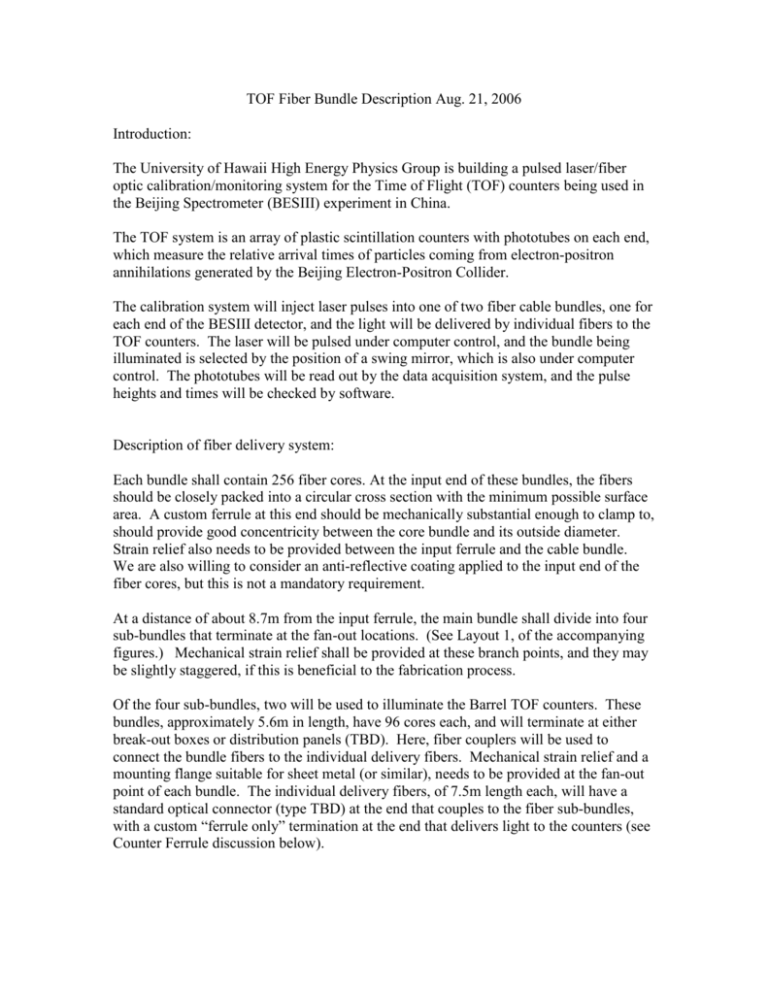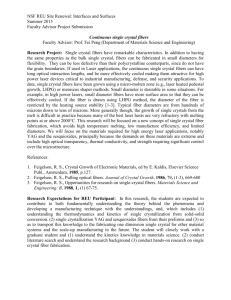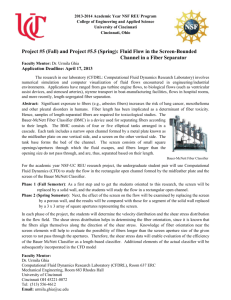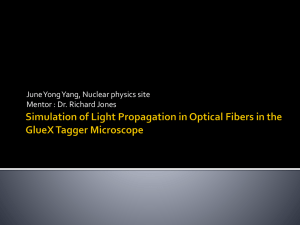TOF_Fiber_Bundle_description_082106
advertisement

TOF Fiber Bundle Description Aug. 21, 2006 Introduction: The University of Hawaii High Energy Physics Group is building a pulsed laser/fiber optic calibration/monitoring system for the Time of Flight (TOF) counters being used in the Beijing Spectrometer (BESIII) experiment in China. The TOF system is an array of plastic scintillation counters with phototubes on each end, which measure the relative arrival times of particles coming from electron-positron annihilations generated by the Beijing Electron-Positron Collider. The calibration system will inject laser pulses into one of two fiber cable bundles, one for each end of the BESIII detector, and the light will be delivered by individual fibers to the TOF counters. The laser will be pulsed under computer control, and the bundle being illuminated is selected by the position of a swing mirror, which is also under computer control. The phototubes will be read out by the data acquisition system, and the pulse heights and times will be checked by software. Description of fiber delivery system: Each bundle shall contain 256 fiber cores. At the input end of these bundles, the fibers should be closely packed into a circular cross section with the minimum possible surface area. A custom ferrule at this end should be mechanically substantial enough to clamp to, should provide good concentricity between the core bundle and its outside diameter. Strain relief also needs to be provided between the input ferrule and the cable bundle. We are also willing to consider an anti-reflective coating applied to the input end of the fiber cores, but this is not a mandatory requirement. At a distance of about 8.7m from the input ferrule, the main bundle shall divide into four sub-bundles that terminate at the fan-out locations. (See Layout 1, of the accompanying figures.) Mechanical strain relief shall be provided at these branch points, and they may be slightly staggered, if this is beneficial to the fabrication process. Of the four sub-bundles, two will be used to illuminate the Barrel TOF counters. These bundles, approximately 5.6m in length, have 96 cores each, and will terminate at either break-out boxes or distribution panels (TBD). Here, fiber couplers will be used to connect the bundle fibers to the individual delivery fibers. Mechanical strain relief and a mounting flange suitable for sheet metal (or similar), needs to be provided at the fan-out point of each bundle. The individual delivery fibers, of 7.5m length each, will have a standard optical connector (type TBD) at the end that couples to the fiber sub-bundles, with a custom “ferrule only” termination at the end that delivers light to the counters (see Counter Ferrule discussion below). The other two bundles will be used to illuminate the End Cap TOF counters. These bundles, approximately 9.0m in length, have 32 cores each, and will need to terminate onto a small panel with a space constraint of 40mm width x 80mm height. At this panel, the bundle fibers will need to fan-out into 32 individual delivery fibers. Hence the use of multi fiber connectors may be both desirable and/or provide the only solution to this space constraint. Delivery fibers: As part of the routine maintenance associated with the BES Collider, the end caps will need to be periodically opened. This will require that the end cap delivery fibers are able to be reliably disconnected and reconnected at the 40mm x 80mm breakout panel. The delivery fibers, which terminate to the barrel counters may also need to be disconnected and reconnected at their break-out boxes, but we anticipate that this will not occur as often as end cap delivery fibers. Disclaimer: We are not experts on the design of fiber optics cables. The design considerations below summarize our understanding at this time of what the cables should look like. Some ideas may be incorrect, and there may be better ways to do things. We appreciate feed back to improve our design. Please feel free to contact us for questions and suggestions on the design: Dr. Fred Harris, Principal Investigator (fah@phys.hawaii.edu, 808 956-2940) Mr. Marc Rosen, Project Engineer (rosen@phys.hawaii.edu, 808 96-6905) ******************************************************************* Design considerations: 1.) Light source: We would like to use a laser diode. However a laser diode is expensive and has much less light output than does a nitrogen-dye laser. It is not certain whether a laser diode provides enough light. If a nitrogen laser is used, there is light to spare, and UH has previous experience using nitrogen-dye lasers with similar fiber optic delivery systems. Therefore, we plan to start with a nitrogen-dye laser but keep maintain the option to switch to a laser diode at a later date. The peak wavelength of the light, in either case, is around 420nm. 2.) Choice of fiber: In order to maintain the option of using a laser diode, then a larger than standard core diameter fiber will be necessary (100 or 200 micron core diameter), with a large core diameter to cladding diameter ratio. This combination should couple with high efficiency, and still provide a relatively small cross section at the laser injection point. A stepped index multi-mode fiber with about a 100 micron core diameter (90 to 110 microns) is probably adequate. The core and cladding should be silicon and have good transmission (< 25 dB/km)) for ~420 nm light. The individual fibers in the bundle may or may not be jacketed. The individual delivery fiber cables on the other side of the distribution boxes will require a jacket; PVC Furcation tubing, or PVC monocoil are possibilities. 3.) Laser end of each bundle: As described above, the fibers without jacketing and without the buffer should be packed tightly together and be captured in a ferrule. The ferrule should be filled with epoxy, and the fiber ends should be polished. The laser beam will illuminate this end of the bundle. It is important that the core intercept a large fraction of the incident light therefore the ratio of core diameter to cladding diameter should be large. If AR coating is available on the surface of this injection point, it will be considered. 4.) Distribution boxes: The distribution boxes allow a transition to easily replaceable delivery fiber cables in the region of the detector where the cables are more likely to be broken. The barrel TOF boxes are in reality coupling panels that connect the individual fibers from the bundles to the individual delivery fiber cables that output to the TOF counters. The EC distribution boxes mount on the back of the EC, and the fiber bundle must be able to be connected/disconnected easily. The size of the box is limited to 40 mm x 80 mm (face) x 100 mm (depth) (1.57 in x 3.15 in x 3.94 in). Both of these constraints suggest the use of multi-fiber connectors here. Possibilities are a single multi-fiber connector or a few multi-fiber connectors on the input side of the box. On the output side, if multi-fiber connectors are used, they must be able to be separated into the individual delivery fibers (see layout 2). However, here because of the limited space for connectors, multi-fiber connectors would need to use the same number of connectors on both input and output faces, such that transition cables are not required. If multi-fiber connectors are turn out to be financially competitive to single fiber connectors, then they might also be considered for the barrel TOF distribution panels. 5.) Connectors: It desirable to use commercial connectors with low insertion losses and high repeatability specifications, for either multi or single fiber connectors. Vendors should propose connector types, which will be subsequently approved by the customer. 6.) Spare fibers: We have specified spare fibers into the design of the main bundles, in the event that breakage occurs during fabrication. There are eight spare fibers in each of the barrel TOF sub-bundles as well as the EC TOF sub-bundles, for a total of 32 spare fibers out of 256 total fibers (= 12.5% spares). We also intend to order spare delivery fibers, for both the barrel and end cap distribution panels. This exact number will be determined as the overall design becomes finalized. 7.) Casing and construction considerations: The bundles should be protected in a casing. Possibilities are SSTL stripwound, PVC monocoil, or stainless steel interlocking tubes covered by black PVC overcoating. Mechanical strain relief should be provided where ever main bundles divide into subbundles and/or individual fiber cables. 8.) Environment: The cable will be located in a high magnetic field, therefore all metal components, including the connectors must be nonmagnetic. The collider hall will both heated and air conditioned as the seasons require. However there may be periods where these indoor climate controls fail. Thus the fiber bundles should be able to withstand the warm summers and cold winters in Beijing, which has weather similar to Chicago. 9.) Counter Ferrules: The ferrules at the counter end of the delivery fibers will be inserted into holes within the mounting flanges of the phototubes and will be glued in place with index matching epoxy. Standard ferrules may be used, but the main requirements are to be able to terminate the fiber cable and to have a well defined length and outer diameter to fit the hole in the mounting flange. The length of the tip of the ferrule should be 7.95 + 0.05 - 0.15 mm and the diameter should be 2.499 +/- 0.001 mm. 10.) Number of sets required: Two cable bundles and two sets of individual delivery fiber cables are required. This provides one complete fiber delivery system for each end of the BES III detector. 11.) Tolerances: The variation between the lengths of the fibers from the laser end ferrule to the distribution panels should be no greater than 2 mm. This requirement applies to the relative specified lengths for the Barrel and/or End Cap sub-bundles, which differ in overall length by ~3.6m. The delivery fibers have the same tolerance requirement. That is, from the distribution panel to either the Barrel or End Cap ferrules, the length variation should be no greater than 2mm (excepting the coarse difference of ~5.5m between these two sets of delivery fibers). The tolerance on the light uniformity over all fibers in the bundle is 5%. In other words, if the laser end of the bundle is illuminated uniformly, the light output at the counter end should be uniform within 5%. The maximum loss from the laser injection point to the TOC counter delivery end should no be less than about 30%.





